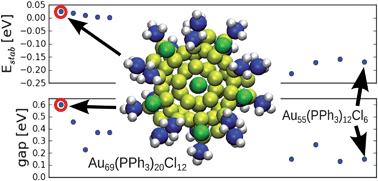A 58-electron superatom-complex model for the magic phosphine-protected gold clusters (Schmid-gold, Nanogold®) of 1.4-nm dimension†
Abstract
We have re-investigated the structural identity of the famous gold-

* Corresponding authors
a
Freiburg Materials Research Center, Stefan-Meier-Straße 21, University of Freiburg, Freiburg, Germany
E-mail:
Michael.Walter@fmf.uni-freiburg.de
b Dep. of Physics, Herrmann-Herder-Straße 3, University of Freiburg, Freiburg, Germany
c Fraunhofer Institute for Mechanics of Materials IWM, Woehlerstr. 11, Freiburg, Germany
d School of Chemistry and Biochemistry, Georgia Institute of Technology, Atlanta, GA, USA
e Departments of Chemistry and Physics, Nanoscience Center, University of Jyväskylä, Jyväskylä, Finland
We have re-investigated the structural identity of the famous gold-

 Please wait while we load your content...
Something went wrong. Try again?
Please wait while we load your content...
Something went wrong. Try again?
M. Walter, M. Moseler, R. L. Whetten and H. Häkkinen, Chem. Sci., 2011, 2, 1583 DOI: 10.1039/C1SC00060H
To request permission to reproduce material from this article, please go to the Copyright Clearance Center request page.
If you are an author contributing to an RSC publication, you do not need to request permission provided correct acknowledgement is given.
If you are the author of this article, you do not need to request permission to reproduce figures and diagrams provided correct acknowledgement is given. If you want to reproduce the whole article in a third-party publication (excluding your thesis/dissertation for which permission is not required) please go to the Copyright Clearance Center request page.
Read more about how to correctly acknowledge RSC content.
 Fetching data from CrossRef.
Fetching data from CrossRef.
This may take some time to load.
Loading related content
